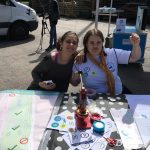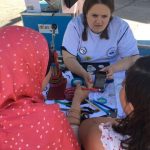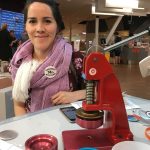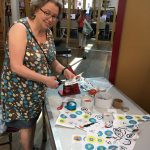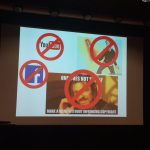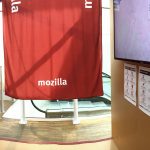As part of Kista Library’s Welcome Refugee Days on 17-20 June I arranged a Mozilla Maker Party to teach the public library users about copyright in everyday life. While copyright might seem like a difficult and dull topic of interest only to a select few (mainly creators and lawyers), it is actually one of the most urgent topics of media and information literacy (MIL).
Why is copyright essential to media and information literacy?
In the 2013 UNESCO publication Media and Information Literacy: Policy and Strategy Guidelines, UNESCO gives ”a full recognition that copyright is essential for enhancing individual creativity, for the advancement of knowledge and cultural expressions, and for the promotion of cultural diversity”, while underlining that there is a difference between protectionism and empowerment when advocating for ethical use of media and information. A protectionist policy would e.g. be ”focus[sing] on copyright of scientific and educational resources”, while an empowering policy would be ”advocacy through MIL for open education resources and open access to scientific information”. Marika Alneng, author of Folkbibliotek i förändring – navigera med medie- och informationskunnighet (The changing public library – a navigation through media and information literacy, my translation), describes copyright as one of eight common denominators for the MIL teaching practises of public libraries in Sweden. She notes – and I wholeheartedly agree – that teaching copyright literacy to librarians (who in turn will teach the library users) could be done on a more positive note. To focus on what you can do, instead of what you can’t do would be much more beneficial for the creativity and innovation that the European Union strives for (cf. (4) in the InfoSoc Directive (2001/29/EC)). Such an empowerment focus should also aim to increase the legal confidence of librarians – a greatly desired skill, as librarians are the citizens’ go-to-persons for all things digital in the information society.
What is a Maker Party?
Mozilla describes their Maker Party as ”a place for artists to connect with educators; for activists to trade ideas with coders; and for entrepreneurs to chat with makers. It’s a place to network, innovate and make a difference.” In 2016, the Maker Party theme of the year was ”to challenge outdated copyright laws in the European Union.” Mozilla had prepared three different activities which all highlighted European copyright absurdities – and how to advocate for changing them – in a modern sharing-is-caring society: Post Crimes, Meme Around, and Contributing to the Commons. Since all 28 member states of the European Union have different copyright legislations, I tweaked the activities to fit the Swedish circumstances. (It is for example a bit unclear to me if the Swedish quotation exception in copyright actually covers the making of memes and reaction gifs. Read more here about the European Parliament’s proposed changes to EU copyright – fingers crossed we can all meme around in the future!)
The Public Art Conundrum of Sweden
However, it is painstakingly clear that publishing pictures of public art online is not allowed according to Swedish copyright law – Sweden’s highest court judged in favour of the Visual Arts Copyright Society in Sweden in their case against Wikimedia Sweden, arguing that while individuals were permitted to photograph artwork on display in public spaces, it was ”an entirely different matter” to make the photographs available in a database for free and unlimited use. But what is a database? Well, BASICALLY EVERYTHING ONLINE. Oxford Dictionaries defines database as:
”[A] structured set of data held in a computer, especially one that is accessible in various ways.”
This means posting pictures of public art in Sweden online (whether it is on a tourist selfie or on a Wikipedia page) is copyright infringement. This includes sharing pictures on social media platforms such as Flickr, Facebook, and Instagram. Oh, to imagine I used to make fun of photographing the Eiffel tower in the day time vs. the night time…!
So, what to make of this? I had an idea.
Activity 1: A City Tour of Public Art
Cameras ready! And back to the Maker Party in Kista: I decided to construct a city tour of public art, where the library users were given a map pointing out public art in the vicinity of the library. They were invited to walk this tour and learn a bit more about the works of art, and by doing so also learning about their local society, it’s history and the cultural landscaping of the city. Indeed, the colourful pillars at the metro station in Kista is not an architectural curiosity like the tower in Pisa, but an artistic interpretation of the transition between rest and dynamic movement. Who knew? PDF’s with the City Tour maps can be found at the bottom of this post. When finishing the tour, the participants were introduced to a second map, one where the location markers had been replaced with either a red x (meaning the work could not be photographed and shared in a digital format) or a green check (meaning the work could be photographed and shared in a digital format). As the Swedish copyright law states that copyright expires 70 years after the author’s death, any public work of art made by an artist who died 1946 or earlier can be photographed and shared freely online.
Konstvandring i Kungsträdgården – beter mig kungligt ! #makerparty #karlxii #kulturallmänningen #wrdkista pic.twitter.com/W4aK3I34QG
— Amelia Andersdotter (@teirdes) June 18, 2017
This means good news for old kings…
Konstrunda i Kungsträdgården. Här replika av staty som är kriminell att fota för delning på internet #makerparty #panoramarätt #wrdkista pic.twitter.com/F7EuOzDA5u
— Amelia Andersdotter (@teirdes) June 18, 2017
… but bad news for Marianne Lindberg de Geer’s sexually hyperactive granite rabbits.
Activity 2: Contributing to the Commons
The second activity was meant to empower the users (much welcomed after introducing the supreme court’s protectionist view on public art) and was presented in a simple poster exhibition which introduced the Swedish copyright law, Creative Commons licences, where to find CC materials, and the photo challenge of Wikimedia Commons. This activity was based on the Mozilla Maker Party activity with the same name. Due to the drop-in organisation of my maker party it wasn’t possible to follow their schedule, but the components were there all the same. The aim was to, in a simple way, explain how digital creativity and copyright can be used to share and remix content, and also showcase how this can be built upon to support digital innovation and entrepeneurship. While it may seem a bit far-fetched, there is a strong connection to the Welcome Refugee Days event: by teaching library visitors about the legal system governing digital innovation and creativity they can get the knowledge and confidence to start their own businesses – which leads to both digital inclusion and integration into society. In other words, getting a key to solve one issue may get you past all those other doors as well.
Materials used in the Maker Party
Click the links to access the city tour maps and the poster exhibition (in Swedish). All map graphics are © OpenStreetMap contributors, and all maps and materials are therefore shared under CC BY-SA 2.0.
- Kista Public Art City Tour – 2 pages, A4
- Kungsträdgården Public Art City Tour – 2 pages, A4
- Poster Exhibition – 4 pages, A3
- soon to be uploaded – maps of answers to the city tours
Gallery from the event
- Data Detox Barista
- Public Art City Walk
- Refugees Welcome (picture by Kista Library)
- Mexican Visitor in Scandinavia
- Maker Space Librarian in Action
- Copyright Infringements
- Freedom of Panorama
Pictures mostly by me; if not, they’re reposted with permission.

